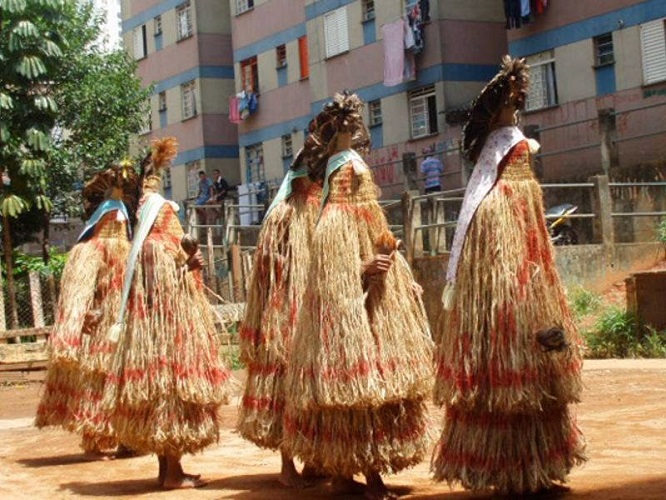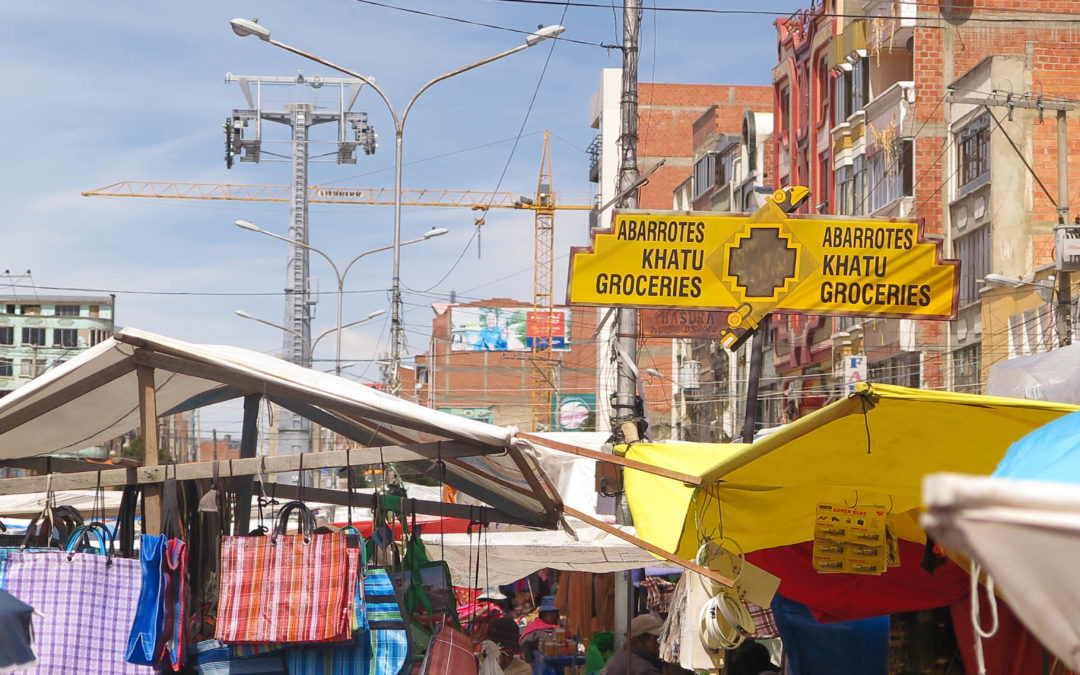By Aiko Ikemura Amaral (UFMG, Brazil), Philipp Horn (University of Sheffield, UK) and Desiree Poets (Virginia Tech, US)
We are living in an increasingly urban world and indigenous peoples are no exception to this trend. In a context of urbanisation, indigeneity does not magically disappear. But how can urban indigeneity be understood, studied and addressed in practice? On 21 March 2019, an interdisciplinary group of academics came together at the University of Sheffield to address this topic as part of the workshop “Indigenous Urbanisation in Latin America”. In this blog, the three workshop organisers provide an overview of key themes discussed during this event.
Authenticity and Racialisation in the City
Indigenous peoples have always lived in cities, increasingly migrate to urban areas, or experience the urbanisation of their territories. In 2010, 35 percent of Latin America’s indigenous population lived in cities and this figure is set to rise beyond the 50 percent mark by 2020. Yet, indigenous peoples that live in cities are often perceived as being ‘less authentic’ than their rural counterparts. In this sense, a focus on indigeneity in urban contexts breaks with expectations of who is able to count as indigenous and where indigenous peoples are ‘allowed’ to dwell.
In the city, rather than losing their indigenous identity, indigenous peoples often reconstruct and transform their identities and practices. One example of this is Aldeia Maracanã, a multi-ethnic indigenous movement in Rio de Janeiro, Brazil. Here, education emerges as a key driving force for instilling and promoting a sense of shared identity for those living outside officially recognised indigenous lands. Women in Aldeia Maracanã have also mobilised around issues of gender by creating a network based on notions of the sacred feminine, thereby combining pan-indigenous representations with new-age philosophy. Such practices contest essentialised understandings of indigeneity in order to foster support for indigenous struggles, creating alliances beyond the indigenous movement itself.
In other cases, however, migration to cities renders people more indigenous, regardless of their own claims. The narratives of Bolivian market women in São Paulo, for example, articulate experiences of racialisation of Bolivian migrants in Brazil. In the media, this process of racialisation is associated with modern forms of slavery and Bolivians’ supposed cultural retraction. While also racialised in this urban context, some Bolivian market women detach their personal experiences of mobility from such alienating discourses by also, and ambiguously, reproducing stereotypes of indigeneity as being associated with anti-modern practices, labour exploitation, and rurality. More than a mere ‘denial’ of indigeneity, these narratives simultaneously rely on the reification and contestation of ruralised representations of indigeneity.
The issue of indigenous authenticity in urban settings is therefore complex and heterogeneous, and tied to local, national, and transnational dynamics.
Dwelling and Urbanisation
Tied to the prejudice that indigenous peoples in urban contexts are ‘less indigenous’ is the fact that, despite documented indigenous urbanisation trends, policy makers, planners and other stakeholders involved in urban governance still conceive of cities as non-indigenous spaces. This can be explained, among other factors, by the living legacy of colonialism which frames urban practice and persists in relation to urban space which remains socially, racially, and culturally segregated.
This does not mean, however, that urban indigenous peoples represent passive victims of exclusion, discrimination, and segregation. For example, in La Paz (Bolivia) and Quito (Ecuador) indigenous residents are increasingly confronting the long legacy of colonialism in their decolonial struggles. They do so by organising around their indigenous identities and by claiming their ‘indigenous rights to the city.’ The latter refer to rights to appropriate urban spaces according to indigenous peoples’ interests and needs as well as rights to be involved in decision making processes affecting them. While Bolivia’s and Ecuador’s constitutions now recognise indigenous rights to the city, the translation of such ambitious legislation into practice has not been straightforward. This is evident especially in settings where political authorities reproduce colonial and racist understandings of cities as ‘white’ spaces. A further complication is that members of indigenous communities, which are often internally divided and marked by uneven power relations as well as intergenerational and gender divisions, sometimes disagree on what ‘indigenous rights to the city’ actually mean.
Urban practices in Brazilian cities such as Manaus and Rio de Janeiro differ from those in La Paz and Quito. For example, instead of claiming ‘indigenous rights to the city,’ Aldeia Maracanã, in Rio, and the Sateré-Mawé in Manaus, seek to revitalise non-urban indigenous forms of organisation such as the aldeia (a term referring to indigenous in Brazil) within urban settings. Similar trends can be noted in the rural community of Charazani in Bolivia. Despite their (built) environment becoming urban as adobe-houses are slowly substituted by more ‘modern’ red-brick ones, indigenous people remain ‘proper persons’ (runa, in Quechua) who preserve their identity and associated practices.
All this speaks against an understanding of urbanisation as directly opposed to indigeneity. Instead, indigeneity (whether rural or urban) undergoes constant transformations that do not necessarily obliterate indigenous identities, relations and practices.

Social Mobility in Cities
Indigenous peoples alter and resignify urban space and are part of (uneven) patterns of urban development. This is the case in La Paz, Bolivia where wealthy Aymara women wearing expensive, multi-layered polleras are migrating to historically ‘non-indigenous’ neighbourhoods. Such spatial and economic shifts speak for a destabilization of racist tropes that depict indigenous people as backwards, poor, and essentially rural.
These changes in La Paz are tied to economic developments in the neighbouring city of El Alto. Here, rapid economic growth and socio-political transformations have led to the emergence of a new Aymara bourgeoisie which, drawing on indigenous practices and networks, introduces a particular form of capitalism in the Andes. But the rise of the Aymara bourgeoisie is part of an uneven process of development, which does not necessarily trickle down to all indigenous individuals operating in urban economies. Instead, a majority of urban indigenous peoples, particularly women and youth, remain trapped in poverty and excluded from education and employment opportunities available in cities. And even in contexts in which women and youth can ascend economically, inequalities and patriarchal structures continue to mark their social mobility.
The example from Bolivia illustrates that the (slow) indigenous economic rise does not necessarily produce cross-class alliances. However, it might contribute to mitigating some forms of racism. Yet, in cases where economic gains are uncertain, processes of racialisation in the urban context might sharpen such inequalities even more.
Urban indigeneity is here to stay
Urbanisation does not obliterate indigenous identities.Neither do indigenous peoples become acculturated as a result of ‘modernisation’ or ‘development.’ Instead, urban indigenous practices constantly recreate, transform, transpose, and reproduce the dynamic character and variety of indigenous social, territorial, political, economic and cultural forms. We have started to address some of these issues in this blog and we invite those interested in more detailed responses to read the papers from the ‘Indigenous Urbanisation in Latin America’ workshop, which can be downloaded here:-
Notes
Authors
Aiko Ikemura Amaral is a Resident Researcher and Lecturer at Center for Development and Regional Planning of the Faculty of Economics at the Universidade Federal de Minas Gerais (Cedeplar/UFMG/Brazil), and her research takes on an intersectional approach to indigeneity and mobility in Bolivia and Brazil.
Philipp Horn is a Lecturer in Urban Studies and Planning at the University of Sheffield with research interests in urban indigeneity in Bolivia and Ecuador.
Desiree Poets is Assistant Professor of Political Science at Virginia Tech. Her research focuses on urban indigenous, maroon, and favela communities in Brazil’s settler colonial present.
Acknowledgments
The authors thank the different contributors of the ‘Indigenous Urbanisation in Latin America’ workshop, including Peter Wade, Gudrun Klein, Jennifer Chisholm, Jonathan Alderman, Kate Maclean, Angus McNelly, Ana Luisa Serta, Dana Brablec and Michael Janoschka.
Header photo by Aiko Ikemura Amaral depicting the 16 de Julio Market, in El Alto, Bolivia. Written in Spanish, Aymara and English, these signs remind us that this is not only the most indigenous city in this country, but that this market is part of a booming and increasingly transnational network of trade led by Aymara and Cholo sectors.
Disclaimer
The views expressed in this article are the authors’ own and do not necessarily represent the position of ILAS or the School of Advanced Study, University of London.


Recent Comments